All the pressure that one goes through in one’s life gradually leads to anxiety. Yoga to relieve anxiety is a series of poses and breathing exercises to relive stress. Anxiety is a disorder that instigates fear, worry, apprehension, and nervousness in one. It is common, one can be anxious because of any reason, from problem in relationship to excessive workload in the office. Just because it is common, we cannot ignore the severity of it. If it is not curbed at the right time, it may lead to further problems. But, there is a good news. There are practices in yoga to relieve anxiety. Yoga is one-of-its-kind practice that helps balance all the aspects of life, such as mind, body, and soul. In this post we are sharing with you some of the best poses of yoga to relieve anxiety.
How Does Yoga Help Relieve Anxiety?
Yoga is often perceived as practice of few asanas or poses, and, most often its benefits are only perceived to be at the physical level. However, it is more than just asanas, it is an art, an effective system of practice, which helps balancing one’s health at physical, mental, social and spiritual level. Yoga is a low-impact exercise, which involves every organ and body part along with our breathing pattern to create harmony in our body and mind. Unlike most workouts, yoga does not just focus on one part of the body, in fact, it brings all the aspects such as mind, body and breathe into one line.
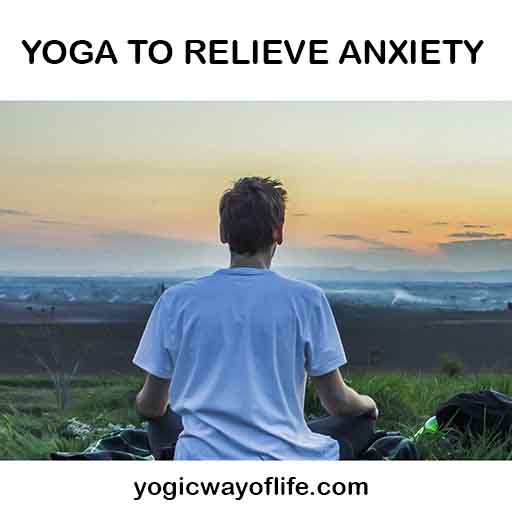
Practicing yoga regularly not only helps in becoming more flexible, toned, and healthy, but also helps us unite with ourselves on a deeper level. Every action we perform in practicing yoga activates nervous system – the brain, muscles, bones, and emotions all at once. Yoga poses bring a holistic change that help us lead a balanced and more fulfilling life. While practicing yoga, our body releases tension and allows the muscles to relax. It activates the parasympathetic nervous system that helps release endorphins, otherwise known as happy hormones. Practicing yoga asanas along with Pranayama can help to relieve stress and anxiety.
Here are some easy poses for you to begin with:
Vipareet Karni Mudra or Half Shoulder Stand
The first in the yoga to relieve anxiety series is Vipareet Karni mudra. Vipareet Karni mudra or Half Shoulder Stand is an easy to do pose that stimulate the entire body and regulates glandular activity, thereby reducing states of anxiety, stress and depression. Besides, it increases lymphatic and venous return, which helps alleviate diseases of the veins. Also, this asana improves blood circulation in the abdominal and pelvic organs, and relaxes these areas.
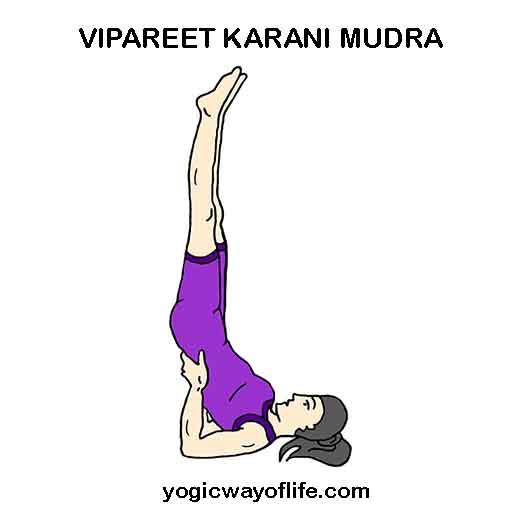
Instructions:
- Lie on your back.
- Place your arms straight, beside your body.
- Take a deep breathe in, while inhaling bend your knees and slowly raise your legs and buttocks.
- Now bring your hands under the buttocks to support the body. While doing so, let your elbow remain on the floor.
- Now straighten your legs vertically upwards and relax the muscles of the feet, legs and hips.
- Keep breathing normally, and remain in this position as long as you are comfortable.
- To exit, exhale, bend your knees towards the forehead, slowly lower your buttocks and legs, and return to the starting position. Relax!
Marjariasana / Bidalasana or Cat-Cow Pose
Next post is Cat-cow pose or Marjariasana / Bidalasana, it provides a gentle massage to your spine. The gentle movement when coordinated with the breath stimulates the belly organs and calms the brain.
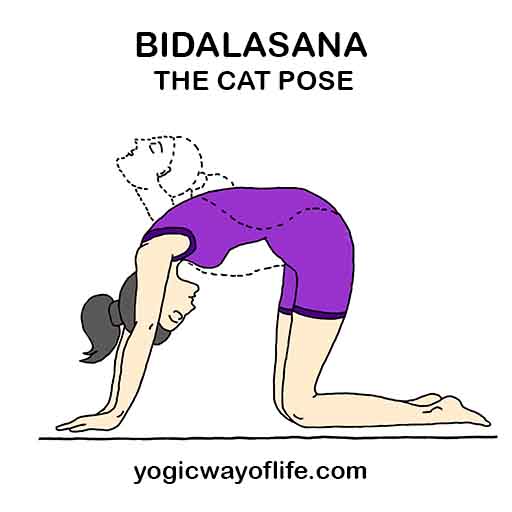
Instructions:
- Start on your hands and knees in a “tabletop” position.
- Your knees should be directly below your hips and your wrists, elbows and shoulders should be in line and perpendicular to the floor.
- Strongly press your palms into the ground and broaden your shoulders and keep the head in a neutral position.
- For Cow Pose: take a deep breath and drop the stomach towards the floor, while uplifting your chest and chin fix your gaze towards the ceiling.
- For Cat pose: Breath out, arch your back towards the sky, pull your stomach to your spine, and touch your chest with chin.
Coordinate the movements and flow from cat to cow and vice-versa with inhalation and exhalation.
Balasana or Child Pose
Balasana or the Child’s Pose is an excellent resting pose. In Sanskrit, Bala means Child and Asana means yoga pose. This asana or pose has been created by observing young children. This pose deeply calms your mind, lengthens the back body, hips and reduces fatigue.
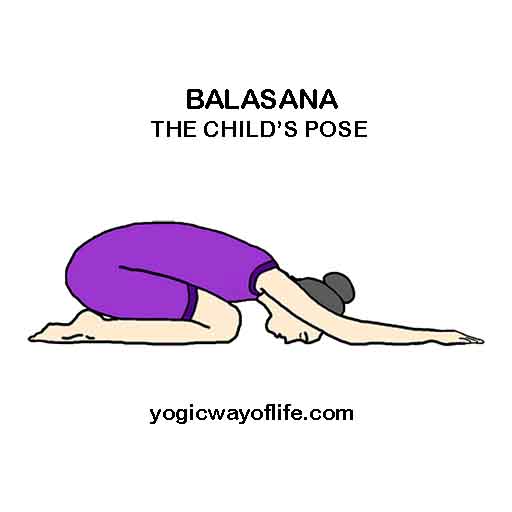
Instructions:
- Start with the kneeling position. Keep the feet and toes together.
- Now, spread your knees slightly apart. Inhale slowly and deeply.
- Slowly bend forward and let your chest rest between the thighs. Exhale as you are bending down. Let your hands be in front of you and resting on the floor, palms facing the mat.
- Adjust your pelvis and sacrum in such a way that your abdomen rests between the inner thighs and the back is stretched forward.
- The forehead should rest on the floor and palms facing downwards, fully touching the mat. The arms should be in line with the knees and fully stretched out and relaxed. If you have difficulty resting the forehead on the floor, you may use a pillow for support.
- Breathe normally in this position and feel the deep relaxation. Remain in this position for as long as you are comfortable.
- To release the pose, move your hands back and slowly raise yourself up to the kneeling position.
Yoga Mudrasana or the Psychic Union Pose
Yoga Mudrasana or the Psychic Union Pose is generally classified as an asana, even though the name suggests that it is a mudra. Primarily, this pose helps tone the spine, lower back and the abdomen. Besides, practicing it regularly gives great flexibility to the back and the hips.
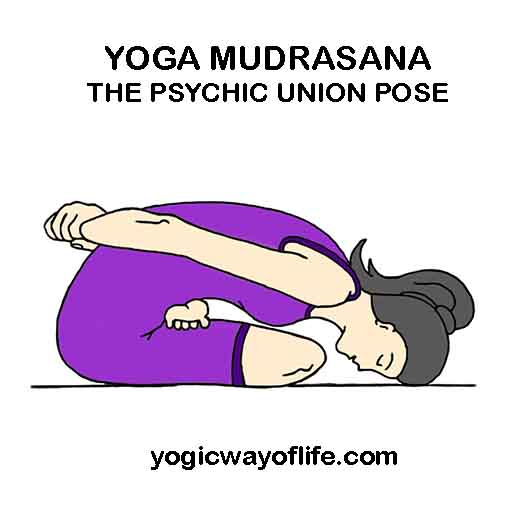
Instructions:
- Sit in Padmasana, the lotus pose, close your eyes and breathe normally.
- Now bring your hands behind the back and hold your left wrist with the right hand.
- Now slowly bend forward and try to touch the floor in front either with your forehead or nose. Make sure you breathe out while bending forward. If you are unable to touch the floor, no problem, go as far as you are comfortable.
- While in the final position, relax your whole body, especially your shoulders and back. Keep breathing deeply and slowly. Try to maintain the position for at least 1 – 2 minutes.
- To exit, slowly lift your forehead, release your hands, and return to the starting position. Inhale while returning to the starting pose.
- If you are not able to maintain the final position for long, then one may do the process a few times.
Bhujangasana or The Cobra Pose
Bhujangasana or the Cobra Pose, is one of the main backward bending asanas used in yoga. In Sanskrit, Bhujanga means a cobra. Bhujangasana is easy to perform and is also integrated into other yoga practices like the Surya Namaskara, where it is the 8th pose in the series of 12 poses.
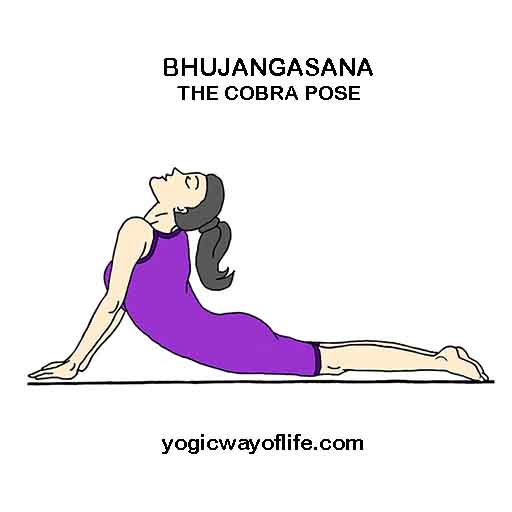
Instructions:
- Lie down on your belly with chin touching the ground.
- Place your hands close to the shoulders with palms touching the ground
- Keep your legs straight.
- Press your palms firmly against the floor.
- As you inhale, lift up your trunk, using your palms as support.
- Gaze towards the ceiling and let your hips be steady.
- Hold the pose for 15-30 seconds and then exhale and release the pose.
Garbhasana or Foetus Pose
Garbhasana or Foetus Pose is called so because the body in this asana is folded up tightly, resembling a foetus. It is a great pose to regulate the adrenal glands and calm an excited mind. Besides, this pose helps alleviate nervous disorders, control anger, stimulate the digestive fire and increase the appetite and tone the abdominal organs.
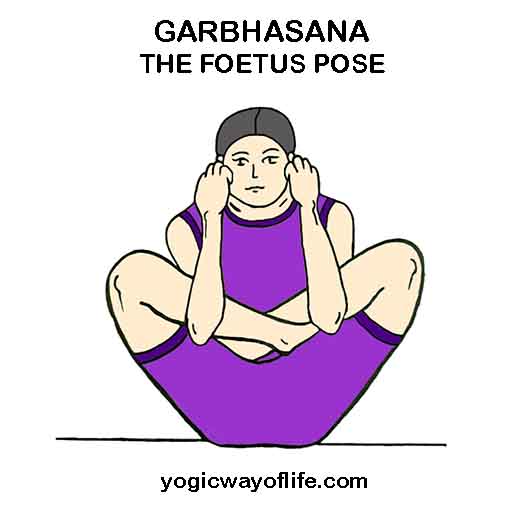
Instructions:
- Sit in Padmasana, the lotus pose.
- Now, insert your left arm between the thigh and calf of the left leg. Gradually, try pushing your arm through the legs up to the elbow.
- In a similar way, insert your right arm between the thigh and calf of the right leg, try pushing your arm through the legs up to the elbow.
- Now raise your legs and fold your arms upwards and catch hold of the left earlobe with your right hand and the right earlobe with your left hand. Stick your neck out so that your hands can reach the ears.
- In this asana, your body is specifically balanced on the coccyx. The arms in this pose have to be inserted between the legs in such a way that your elbows can be bent fully, reaching the hands to the ears.
- To exit, release your hands first and slowly lower your legs to the ground. First, release your right hand from between the legs, then release your left hand and return to the starting position.
Matsya Kridasana – Flapping Fish Pose
The last in the yoga to relieve anxiety series is Matsya kridasana. Matsya Kridasana or the Flapping fish Pose is called so because it resembles a playful fish flapping its tail and fins. It is one of the relaxation asanas in yoga that is even used for sleeping. Besides, it relaxes the lower back and helps in relieving sciatic pain.
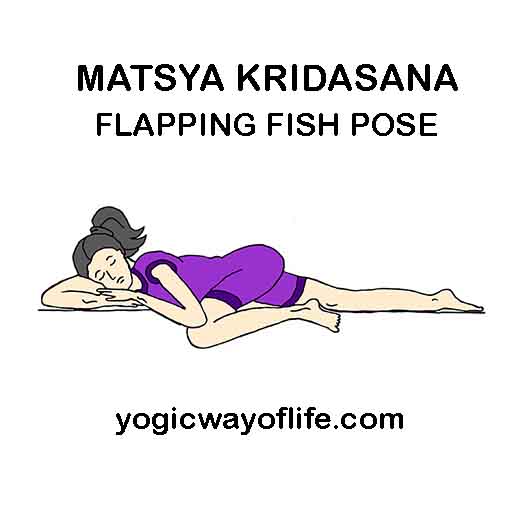
Instructions:
- Lie down on your belly in a relaxed way and turn your neck to your left side.
- Now place your right hand palms over the left hand and rest your head on top of your hand (back of the palms). Your head should face to the left.
- Now bend your left leg and move your left knee as close to the ribs as possible.
- The right leg should remain straight.
- In the final position, your body will be relaxed and you will feel a slight tug or pull on the waist region.
- Maintain the position for as long as you are comfortable.
- Breathe slowly and normally, maintain awareness of the breath. Let every part of your body relax!
- Similarly, you can repeat the pose with your head turned towards the right side. In this case keep your right leg folded and the left leg straight.
PRANAYAMA TO RELIEVE ANXIETY
Performing pranayama after the yoga session is very good for one’s overall health. Prāṇāyāma is an art of conscious breathing, helps you release any kind of anxiety or stress along with strengthening your energy positively.
Anulom Vilom or Alternate Nostril Breathing
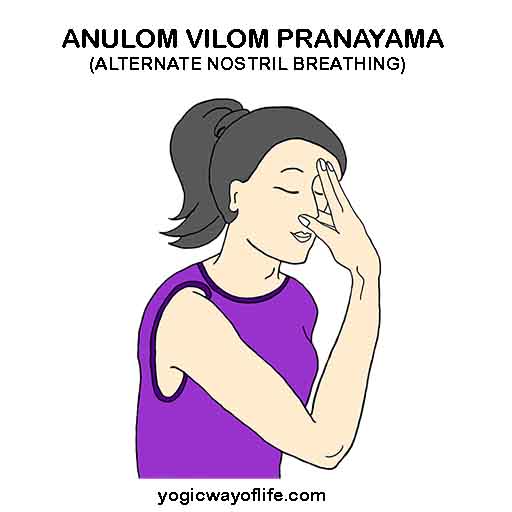
A very simple breathing exercise, known to balance the Tridoshas in the body, namely Vata, Pitta and Kapha. More often than not, imbalanced Tridoshas causes ailments in the body. Anulom Vilom is the easiest and the most effective way to stay healthy and have a calm mind.
Kapalbhati Pranayama
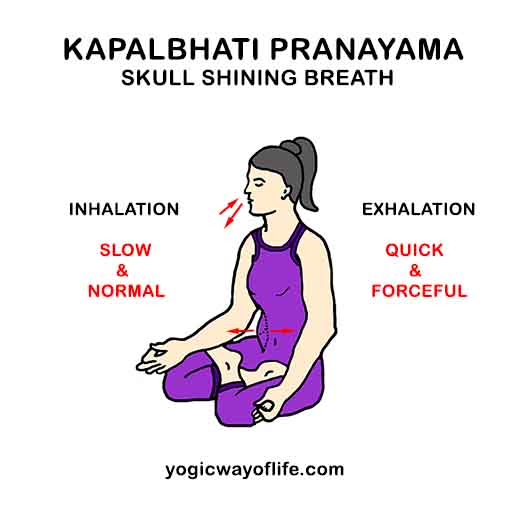
A great way to detoxify the body, as, the technique helps in expelling carbon-di-oxide from the blood. This breathing technique needs minimal effort, however, comes with a plethora of benefits.
Bhramari Pranayama
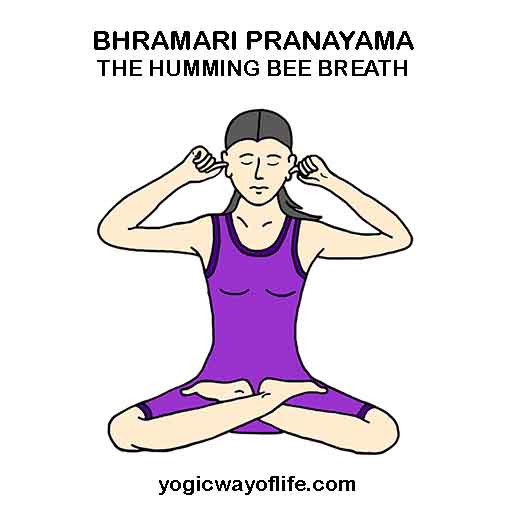
Commonly known as bee breathing exercise. It involves humming like a bee, with ears covered with the forefingers and thumbs. Bhramari pranayama calms the nerves and soothes them especially around the brain and forehead.
Lastly, you can do any form of meditation of your choice, from mindfulness to focusing mind on a particular object or your breath. Concluding yoga and pranayama with few minutes’ meditation calms down the mind and helps retain the energy.

Hari OM
Thank you for sending this wonderful Article.
Warm Regards
Arun Kumar.R